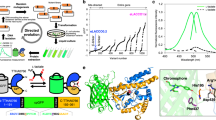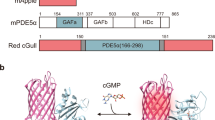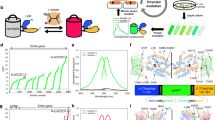Abstract
This protocol details a method for monitoring glucose uptake into single, living mammalian cells using a fluorescent D-glucose derivative, 2-[N-(7-nitrobenz-2-oxa-1,3-diazol-4-yl)amino]-2-deoxy-D-glucose (2-NBDG), as a tracer. The specifically designed chamber and superfusion system for evaluating 2-NBDG uptake into cells in real time can be combined with other fluorescent methods such as Ca2+ imaging and the subsequent immunofluorescent classification of cells exhibiting divergent 2-NBDG uptake. The whole protocol, including immunocytochemistry, can be completed within 2 d (except for cell culture). The procedure for 2-NBDG synthesis is also presented.
This is a preview of subscription content, access via your institution
Access options
Subscribe to this journal
Receive 12 print issues and online access
$259.00 per year
only $21.58 per issue
Buy this article
- Purchase on Springer Link
- Instant access to full article PDF
Prices may be subject to local taxes which are calculated during checkout






Similar content being viewed by others
Change history
09 August 2007
In the version of this article initially published, on p. 754 under “Reagents,” “N-(7-nitrobenz-2-oxa-1,3-diazol-4yl-)amino chloride” should have been “4-Chloro-7-nitrobenzofurazan”. The error has been corrected in the HTML and PDF versions of the article.
References
Sokoloff, L. Sites and mechanisms of function-related changes in energy metabolism in the nervous system. Dev. Neurosci. 15, 194–206 (1993).
Heimberg, H., De Vos, A., Pipeleers, D., Thorens, B. & Schuit, F. Differences in glucose transporter gene expression between rat pancreatic a- and b-cells are correlated to differences in glucose transport but not in glucose utilization. J. Biol. Chem. 270, 8971–8975 (1995).
Sokoloff, L. et al. The [14C]deoxyglucose method for the measurement of local cerebral glucose utilization: theory, procedure, and normal values in the conscious and anesthetized albino rat. J. Neurochem. 28, 897–916 (1977).
Turkheimer, F. et al. The use of spectral analysis to determine regional cerebral glucose utilization with positron emission tomography and [18F]fluorodeoxyglucose: theory, implementation, and optimization procedures. J. Cereb. Blood Flow Metab. 14, 406–422 (1994).
Dienel, G.A., Cruz, N.F., Adachi, K., Sokoloff, L. & Holden, J.E. Determination of local brain glucose level with [14C]methylglucose: effects of glucose supply and demand. Am. J. Physiol. 273, E839–E849 (1997).
Axelrod, J.D. & Pilch, P.F. Unique cytochalasin B binding characteristics of the hepatic glucose carrier. Biochemistry 22, 2222–2227 (1983).
Yoshioka, K. et al. A novel fluorescent derivative of glucose applicable to the assessment of glucose uptake activity of Escherichia coli . Biochim. Biophys. Acta 1289, 5–9 (1996).
Matsuoka, H. et al. Viable cell detection by the combined use of fluorescent glucose and fluorescent glycine. Biosci. Biotechnol. Biochem. 67, 2459–2462 (2003).
Yamada, K. et al. Measurement of glucose uptake and intracellular calcium concentration in single, living pancreatic β-cells. J. Biol. Chem. 275, 22278–22283 (2000).
Miyazaki, J. et al. Establishment of a pancreatic beta cell line that retains glucose-inducible insulin secretion: special reference to expression of glucose transporter isoforms. Endocrinology 127, 126–132 (1990).
Lloyd, P.G., Hardin, C.D. & Sturek, M. Examining glucose transport in single vascular smooth muscle cells with a fluorescent glucose analogue. Physiol. Res. 48, 401–410 (1999).
Roman, Y., Alfonso, A., Carmen Louzao, M., Vieytes, M.R. & Botana, L.M. Confocal microscopy study of the different patterns of 2-NBDG uptake in rabbit enterocytes in the apical and basal zone. Eur. J. Physiol. 443, 234–239 (2001).
Ball, S.W., Bailey, J.R., Stewart, J.M., Vogels, C.M. & Westcott, S.A. A fluorescent compound for glucose uptake measurements in isolated rat cardiomyocytes. Can. J. Physiol. Pharmacol. 80, 205–209 (2002).
Loaiza, A., Porras, O.H. & Barros, L.F. Glutamate triggers rapid glucose transport stimulation in astrocytes as evidenced by real-time confocal microscopy. J. Neurosci. 23, 7337–7342 (2003).
Bernardinelli, Y., Magistretti, P.J. & Chatton, J.-Y. Astrocytes generate Na+-mediated metabolic waves. Proc. Natl. Acad. Sci. USA 101, 14937–14942 (2004).
Porras, O.H., Loaiza, A. & Barros, F. Glutamate mediates acute glucose transport inhibition in hippocampal neurons. J. Neurosci. 24, 9669–9673 (2004).
Itoh, Y., Abe, T., Takaoka, R. & Tanahashi, N. Fluorometric determination of glucose utilization in neurons in vitro and in vivo . J. Cereb. Blood Metab. 24, 993–1003 (2004).
Blomstrand, F. & Giaume, C. Kinetics of endothelin-induced inhibition and glucose permeability of astrocyte gap junctions. J. Neurosci. Res. 83, 996–1003 (2006).
O'Neil, R.G., Wu, L. & Mullani, N. Uptake of a fluorescent deoxyglucose analogue (2-NBDG) in tumor cells. Mol. Imaging Biol. 7, 388–392 (2005).
Cheng, Z. et al. Near-infrared fluorescent deoxyglucose analogue for tumor optical imaging in cell culture and living mice. Bioconjug. Chem. 17, 662–669 (2006).
Nakata, M. et al. Effects of statins on the adipocyte maturation and expression of glucose transporter 4 (SLC2A4): implications in glycaemic control. Diabetologia 49, 1881–1892 (2006).
Zou, C., Wang, Y. & Shen, Z. 2-NBDG as a fluorescent indicator for direct glucose uptake measurement. J. Biochem. Biophys. Methods 64, 207–215 (2005).
Yoshioka, K. et al. Intracellular fate of 2-NBDG, a fluorescent probe for glucose uptake activity, in Escherichia coli cells. Biosci. Biotech. Biochem. 60, 1899–1901 (1996).
Minami, K. et al. Insulin secretion and differential gene expression in glucose-responsive and -unresponsive MIN6 sublines. Am. J. Physiol. Endocrinol. Metab. 279, E773–E781 (2000).
Yada, T., Itoh, K. & Nakata, M. Glucagon-like peptide-1-(7-36)amide and a rise in cyclic adenosine 3,5-monophosphate increase cytosolic free Ca2+ in rat pancreatic beta-cells by enhancing Ca2+ channel activity. Endocrinology 133, 1685–1692 (1993).
Acknowledgements
We are grateful to our collaborators, Drs. Masanori Nakata and Naoki Horimoto. We also thank Drs. K. Yoshizaki and S. Sato for technical help, and Dr. J. Miyazaki (Osaka University) for providing us with MIN6 cells.
Author information
Authors and Affiliations
Corresponding authors
Ethics declarations
Competing interests
The authors declare no competing financial interests.
Rights and permissions
About this article
Cite this article
Yamada, K., Saito, M., Matsuoka, H. et al. A real-time method of imaging glucose uptake in single, living mammalian cells. Nat Protoc 2, 753–762 (2007). https://doi.org/10.1038/nprot.2007.76
Published:
Issue Date:
DOI: https://doi.org/10.1038/nprot.2007.76
This article is cited by
-
Single-cell mapping of lipid metabolites using an infrared probe in human-derived model systems
Nature Communications (2024)
-
Antagonizing Effects of Chromium Against Iron-Decreased Glucose Uptake by Regulating ROS-Mediated PI3K/Akt/GLUT4 Signaling Pathway in C2C12
Biological Trace Element Research (2024)
-
PD-1 instructs a tumor-suppressive metabolic program that restricts glycolysis and restrains AP-1 activity in T cell lymphoma
Nature Cancer (2023)
-
Multimodal molecular imaging evaluation for early diagnosis and prognosis of cholangiocarcinoma
Insights into Imaging (2022)
-
Single cell metabolism: current and future trends
Metabolomics (2022)
Comments
By submitting a comment you agree to abide by our Terms and Community Guidelines. If you find something abusive or that does not comply with our terms or guidelines please flag it as inappropriate.



